Anti-aircraft armored car "Pearless"
At the end of 1914, when domestic enterprises began construction of the first domestic anti-aircraft armored cars, the Main Artillery Directorate ordered similar equipment from the British company Vickers. In accordance with the signed agreement, British experts had to book 16 armored cars and install the latest automatic guns QF 2 pounder Mark II on them. It is noteworthy that the Russian military ordered these guns a few months before they were adopted by the Royal Navy fleet UK.
According to the “traditions” of that time, the developers of the anti-aircraft self-propelled gun project planned to take as a basis the finished chassis of a production truck. It was proposed to remove all unnecessary parts from the machine, instead of which the armored hull of the original design should be installed. The project involved the use of a relatively high armored hull, the combat compartment of which would not have a roof. So it was planned to provide the possibility of firing at air targets.
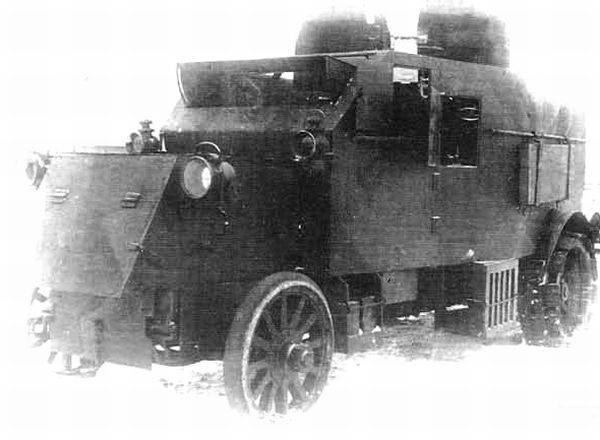
General view of the machine "Pierless"
According to a study of the available technology, it was decided to base the three-ton truck TC3 of the American company Peerless Motor Company. According to its characteristics, this machine met the requirements of the customer, thanks to which it could be used in the project. In addition, the choice of the chassis was facilitated by the fact that TC3 type machines were built not only in the USA, but also at the British factory Wolseley. Thus, all the new type of armored vehicles were based on the English assembly chassis. British-made serial armored cars subsequently “inherited” the name of the base chassis. In domestic and foreign sources, they are referred to as "Pearless."
Like many other trucks of the time, the Peerless had a frame structure with a front-engine layout. The car was equipped with a gasoline engine with liquid cooling capacity 32 hp The main elements of the mechanical transmission were a four-speed gearbox and chain drive. The undercarriage with a wheel formula 4х2 had a dependent suspension based on leaf springs. The front wheels were connected to the steering gear. All wheels had a design based on the spokes. The front axle was equipped with single wheels, rear - dual gable.
On such a chassis it was planned to install an armored frame structure. Protection of the crew and units of the machine from the bullets of the enemy was provided by 8-mm armor plates. All elements of the armored hull had the same thickness. During assembly, the armor plates were attached to the frame with bolts and rivets. Thus, from the point of view of the hull architecture, the Pearless armored car was a typical machine of its class.
Above the base chassis, an armored hull was installed. In addition, several armor plates were provided, fastened to the frame and protecting it from damage. The armored hull was divided into three sections: a small-sized engine compartment, a command and control unit and a combat compartment. Both habitable compartments were made in the form of a single volume without partitions. At the same time, however, the department of management, unlike the fighting department, had a roof.
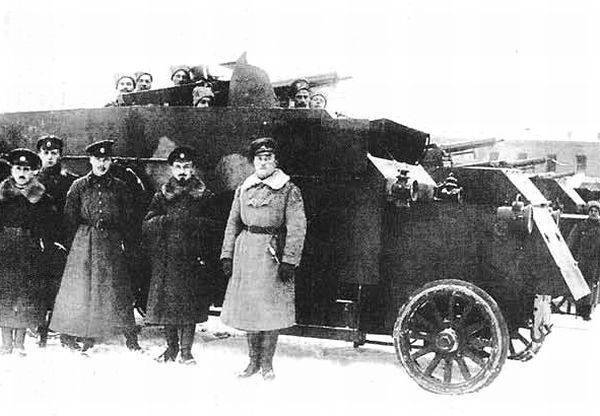
Armored car and its crew
The armored hood of the engine compartment had an extremely simple design. It was made in the form of a rectangular metal box with a sloping front wall. For ventilation of the compartment, the frontal sheet was divided into two parts, the lower of which was movably mounted. In the stowed position, the bottom sheet rose and improved cooling of the radiator. In the sides of the hood, hatches for maintenance were opened to the side.
Immediately behind the hood, the body of the car expanded dramatically: directly behind the engine compartment there was a relatively large vertical partition. Above this detail was a sloping frontal sheet with a wide viewing hatch. To protect against shelling in a combat situation, the driver could close the hatch with a lowered lid with inspection slits.
The sides of the habitable compartment were arranged vertically, but in the front part they diverged to the sides at a slight angle. This was done to increase the maximum width of the fighting compartment, where the gun was located with the calculation. There were two armored windows in the front of the sides that could be used to improve visibility from the driver’s seat. Behind these windows, side doors were provided consisting of two halves. To get into the car, one had to open both flaps, while the open top provided ventilation of the crew compartment and allowed to monitor the situation.
The Pirless armored car did not receive a full roof. On top of the 8-mm armor plates, only the driver’s cabin and the aft hull were protected. The central part of the habitable roof compartment did not have. Behind the body was protected by a vertical armor plate.
In the center of the fighting compartment located tumbovoy installation for anti-aircraft guns. Attachment systems for the gun provided an azimuth circular guidance and vertical guidance ranging from -5 ° to + 80 °. To rotate and lift the gun, a gear wheel and a gear arc were used; mechanisms were equipped with manual drives. Due to the relatively high supporting pedestal, the gun was located above the hull sides and had no restrictions on horizontal guidance.
The Main Artillery Directorate ordered the British company Vickers 16 "40-mm automatic cool guns" of the type QF 2 pounder Mark II. For the characteristic sounds during the operation of the mechanisms, these guns received the nickname “Pom-Pom”. The gun had a caliber 40 mm, barrel length 39,37 caliber and was designed to use shells 40x158R. Being a further development of the Vickers machine gun, the new gun had automation based on a short barrel stroke. The rate of fire was up to 90-120 shots per minute. The gun was equipped with a mechanical sight.
The cannon was fed with ribbons on 25 shells. The ammunition consisted of two types of grenades: one of them was equipped with a 10-second tube, the other - 18-second. Shells weighing about 0,92 kg had an initial speed of the order of 600 m / s. The maximum effective range of fire reached 3,9 km. For the shooting should use special tracer shells, the so-called. trajectory determinants.
For self-defense promising anti-aircraft armored car was supposed to get one Lewis machine gun. it weapon It was supposed to be transported in packing and retrieved only when necessary. Special attachments for the machine gun did not provide. It should be used by setting on board or putting in one of the windows.
The crew of the Peerless armored car consisted of five people. The commander and the driver were located in the department of management. Places of three gunners were in the fighting compartment.
The combat mass of an anti-aircraft armored car reached 4,8 t. The available 32-strong engine allowed it to reach speeds up to 40-45 km / h. The range, according to various sources, ranged from 150 to 250 km.
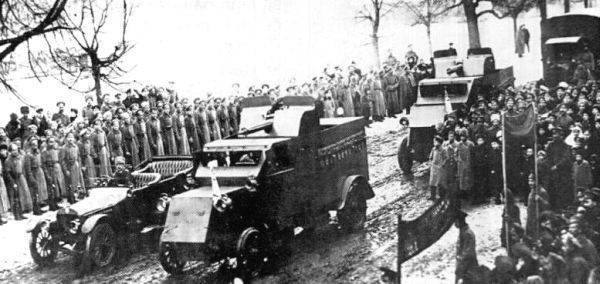
The Pearless TC3 trucks and QF 2 pounder Mark II cannons were manufactured in the UK, but this did not make it possible to speed up the construction of armored vehicles for Russia. For some reason, construction lasted for about a year and a half: 16 armored cars were assembled only by the end of the spring of 1916. Soon they were sent to the customer. It took three more months to transport the equipment. Cars arrived in Russia only in September.
At the beginning of autumn, the Russian military tried out new equipment and were generally satisfied. Nevertheless, it was decided to modify the new technique. The Russian specialists were not satisfied with the existing design of armor protection. Soon, the gun installation of each armored car was supplemented with a large shield with an embrasure for the gun. This unit, made of 8-mm sheets, had a large frontal sheet and two small sides.
About a month after the transfer to the customer, the armored cars were transferred to the 1 heavy artillery reserve brigade, which was to use them to protect ground forces from an air attack, and also to stop the reconnaissance flights.
For some reason, sending vehicles to the army was delayed. Only at the end of January were four separate armored batteries formed for firing at the air fleet with numbers from 1 to 4. It was assumed that over the next few weeks the new formations would go to the front and take part in the fight against the enemy aviation. However, sending to the front was again delayed. Now the reason for this is the events in Petrograd.
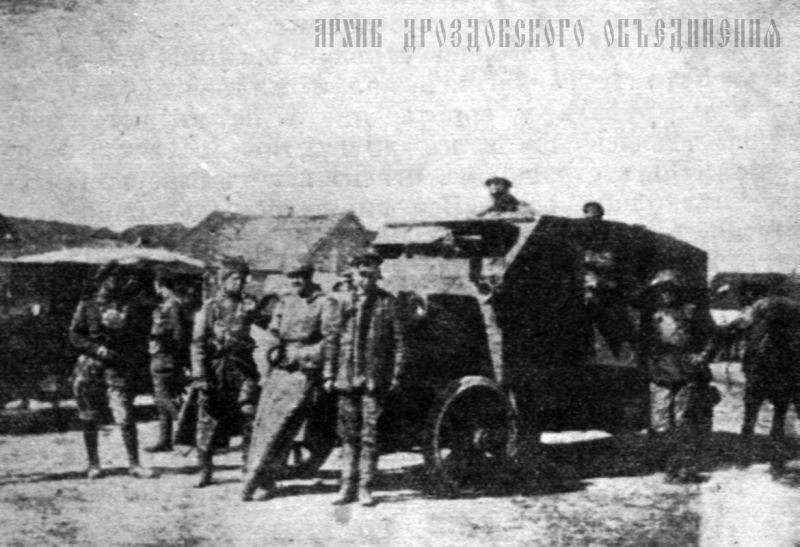
The armored car with its own name "Faithful", operated by the White Guards. The gun was dismantled and replaced, presumably, by a machine gun. 1919
Because of the February Revolution, a lot of armored vehicles, which were planned to be sent to the front, were left in the capital. For some time, Pirless vehicles and other armored vehicles were used to patrol the streets and participated in some other activities. Transfer of cars to the army before the scheduled time was not planned.
In Petrograd, there were several forces that wanted to get their hands on armored vehicles. Because of this, in the middle of the spring 1917, it was decided to send four batteries for firing at the air fleet to the front. The situation on the fronts of the First World War began to deteriorate rapidly, due to which the troops urgently needed to be replenished. In addition, sending to the front allowed to “save” the machine from falling into the wrong hands with the sad consequences for the existing government.
Accurate information about the service of the four batteries is missing. Only the results of a short period of life of an 3 separate battery are known. On May 20, four vehicles of this unit arrived at Sinyavka station and went over to the 15 Siberian division of the 9 Army Corps of the 2 Army. 22 May crews of anti-aircraft armored vehicles joined the combat work.
3 Jun won their first Pirlessa 22 battery victory. Carrying out the air defense of one of the artillery formations, the anti-aircraft gunners fired at the enemy reconnaissance aircraft. Armored cars have used 147 shells of several types. As a result of the bombardment, the enemy airplane received engine damage, after which it continued flying with a noticeable decrease. Anti-aircraft gunners observed the smoke trail of the aircraft.
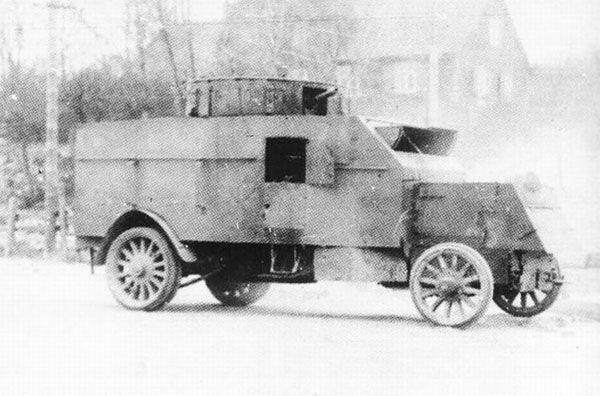
Armored car, inherited the Estonian army. Instead of a stand with a gun mounted tower with machine guns.
23 June around 7: 20 am anti-aircraft armored vehicles covered the artillery again. An enemy reconnaissance aircraft appeared in the sky again. Having spent 170 shells, the battery caused damage to the aircraft, after which it began to smoke, went into a dive and crashed to the ground.
40-mm anti-aircraft guns, which were the main weapon of the new armored vehicles, had a sufficiently high efficiency and made it possible to inflict serious damage or even shoot down enemy aircraft. For this reason, it can be assumed that the 1-I, 2-I and 4-I separate batteries, like 3-I, managed to shoot down several airplanes during the fighting.
In the summer of 1917, the situation at the front worsened, the summer offensive of the Russian armed forces failed, because of what the initiative went to the enemy. The command had to urgently change the strategy and look for ways out of this situation. One of the answers to new difficulties was the creation of a so-called. parts of death. They included 2-I separate armored battery for firing at an air fleet. Details of the battery’s combat performance during this period are unknown.
According to reports, after the October Revolution, the Pirless armored cars took part in the Civil War, adding to the fleet of vehicles of both opposing sides. This technique was used both by the Red Army and the White Guards. It is also known that by the year 1919, at least one armored car with an anti-aircraft gun went to the Estonian army. It is possible that in the course of hostilities, the Red and White equipment from time to time became a trophy and changed the owner.
Surviving photographs show that Peerless armored cars underwent several changes during operation during the Civil War. Due to certain problems with the original weapons, this technique received a new weapon. So, in some photos armored cars are depicted, in which instead of installation with a gun and a shield a machine-gun tower is mounted. At least one of the “Estonian” armored cars passed such a modernization.
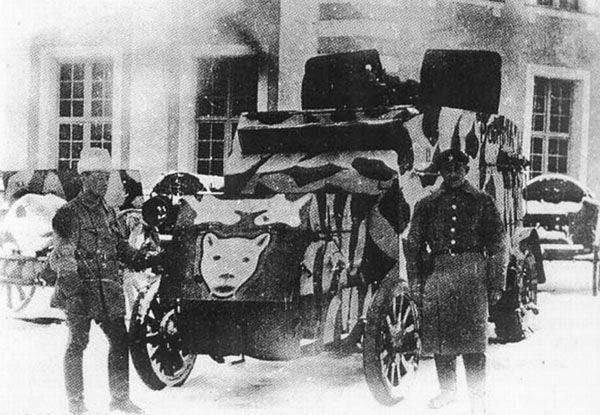
One of the cars inherited Poland. Armament remains the same
After the end of the Civil War, all the surviving "Pirlessa" served in the Red Army. In 1920, some of these machines participated in the war with Poland. Two armored cars eventually became trophies of the Polish army and were exploited by it over the next few years.
The Pirless anti-aircraft armored car service in the Red Army continued, according to various sources, until the beginning or the end of the twenties. According to some sources, the last cars of this type were written off by the 1921-22 years, others say the end of the service by the end of the decade. One way or another, no later than by the beginning of the thirties, all the remaining Pirless armored cars had exhausted their resources and were written off for the lack of prospects.
Pirless armored cars with QF 2 pounder Mark II anti-aircraft guns eventually became the most widely-represented representatives of their class in the Russian Imperial Army. In the autumn of 1916, the 16 machines of this type were transferred to Russia. For comparison, the armored "Russo-Balt Type T" were built in the amount of four units, and the self-propelled self-propelled gun "Austin" remained in a single copy.
According to some reports, back in 1915, the anti-aircraft armored cars based on the Peerless TC3 were interested in the British command, which soon ordered a certain amount of such equipment. However, it was not possible to find any information about this order. There may be some confusion. In service with the British army there were indeed armored cars equipped with Pom-Pom guns. In addition, in 1919, a new armored car was built on the Pirless chassis, but it carried machine-guns. Information about the Peerless armored car with a 40-mm automatic cannon is missing.
Based on:
http://aviarmor.net/
http://warwheels.net/
http://imcdb.org/
Baryatinsky MB, Kolomiets M.V. Armored cars of the Russian army 1906 – 1917 - M .: Technics-youth, 2000
Solyankin A. G., Pavlov M. V., Pavlov I. V., Zheltov I. G. Domestic armored vehicles. XX century. - M .: Exprint, 2002. - T. 1. 1905 – 1941
- Ryabov Kirill
- Baryatinsky MB, Kolomiets M.V. Armored cars of the Russian army 1906 – 1917, Aviarmor.net
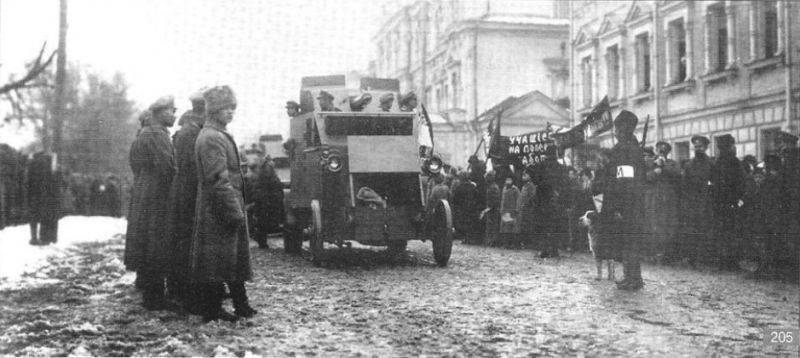
Information